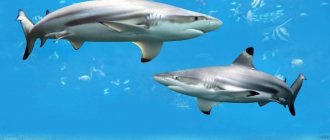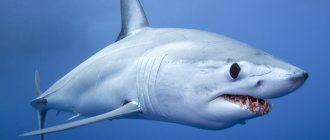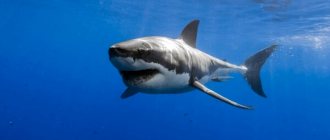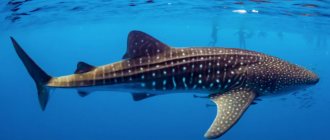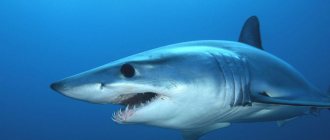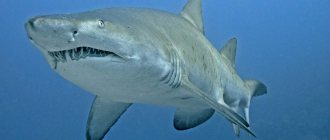The Atlantic herring shark (Lamna nasus) is a typical pelagic predator.
Together with its closest relative, the Pacific herring (or salmon) shark (Lamna ditropis), it constitutes a genus of herring sharks of the same family (the second name is lamnaidae).
In addition to the genus Lamna, ichthyologists include in the same family the great white (Carcharodon) and three species of blue-gray sharks (including mako).
Atlantic herring shark
This shark belongs to the herring shark family of the order Lamniformes and has a characteristic appearance for this species.
All predators of this order have five gill slits, dorsal and anal fins. They are armed with very sharp teeth, but they do not have a nictitating membrane. These are the structural features of the herring shark. The appearance of the Atlantic shark is quite ordinary for representatives of this family. The body is quite thick, spindle-shaped, the caudal fin is in the shape of a crescent, the snout is sharp and conical.
The upper part of the body has a bluish-gray color (from light to the darkest shade), but the peritoneum is very light, almost white. There are no spots or stripes on the body.
The eyes are large. The teeth are quite large, triangular in shape, and in adult sharks, at the base of each tooth, a couple more small ones grow on both sides. Imagine that there are up to sixty teeth on each jaw.
A shark lives from twenty-five to thirty years.
The Atlantic herring shark reaches quite large sizes. There are facts about the existence of specimens up to 3.7 m in length and weighing up to two hundred and thirty kilograms. However, the usual average size of a predator is from one and a half to two meters, while its weight is about one hundred kilograms.
Blue shark - fatal beauty
In penultimate, ninth place is another shark with an unusual color, this time blue. The blue or cyan shark has an indigo back, blue sides, and a perfect white belly.
This colorful predator, with a spindle-shaped shape and long pectoral fins, can be found in tropical, subtropical and temperate latitudes of the Pacific Ocean.
Nature has deprived these fish of the ability to distinguish colors, rewarding them with excellent orientation and sensitive recognition of subtle contrasts.
The length of the blue shark is on average 3-4 meters, and opinions about its aggressiveness are often contradictory, but most researchers agree that these fish are extremely warlike and are ready to attack the enemy at any moment.
Photo: Blue Shark
How does the Atlantic shark live?
The lifestyle of the herring shark is no different from the behavior of other representatives of this genus. She is constantly on the move throughout her life, sometimes resting at the bottom. The shark does not have a swim bladder, which means it does not have the buoyancy that ordinary fish have. This fact forces her to constantly move, otherwise she will simply drown.
Even a dead herring shark will never rise to the surface; it finds refuge at the bottom or becomes prey for scavengers. In addition, she knows how to maintain the desired temperature of her body, which is higher than the temperature of sea water. How does she do this? The herring shark has its own thermoregulation mechanism. Everything happens quite simply. The blood in the muscles circulates through special heat exchangers, where it is heated. Thus, the shark raises its body temperature by seven to ten degrees. This amazing property helps predators quickly adapt to cold water and makes it possible to move faster in pursuit of prey.
Behavior and biology
The mako shark is considered one of the fastest and most agile shark species; it can reach speeds of up to seventy-four kilometers per hour. She can easily jump out of the water into the air to a height of six meters, making a series of such jumps. The shark has the ability to quickly gain speed while pursuing its prey. In one of the experiments, the animal was able to reach a speed of one hundred and ten kilometers per hour.
These sharks have a unique circulatory system. It is an interweaving of veins and arteries, which allows sharks to maintain a body temperature higher than that of the environment (up to two degrees). This net is located on the sides of the animal. It is possible to maintain heat and save it by warming up the arterial blood at the expense of the venous blood. The venous one heats up during muscle contractions - in motion.
Where do herring sharks live?
The Atlantic herring shark lives in waters that extend from the Western Atlantic to Argentina and Brazil. The habitat is quite wide. In the eastern Atlantic, the shark is found in both Iceland and South Africa. Sometimes it can be seen in the Mediterranean Sea.
The Atlantic shark is able to adapt well, and therefore it feels equally comfortable both in open water and in the coastal waters of islands and continents. For her, not very warm waters with a temperature of no more than twenty degrees are more preferable.
Is it possible to see makos in captivity?
For many years people have been trying to tame the mako shark and stock this species in swimming pools. Many times they tried to place makos in aquariums, where the environment was close to natural. But all these attempts were unsuccessful. The longest time a mako shark has ever lived in an aquarium is believed to be five days spent by the shark in New Jersey. The animal was brought there completely healthy. The shark started hitting the walls and refused to eat. Subsequently she weakened and died. Live mako sharks can be seen off the coast of South Africa and the Maldives. Ecotourism—diving underwater where sharks swim—is thriving here.
What does the Atlantic predator eat?
The basis of the shark's diet is herring, and therefore fishermen believe that if you want a herring shark, you must first find a school of fish. The predator lives at a depth of 700-800 meters from the surface of the sea.
Its diet includes sardines, tuna, herring, and mackerel. He also does not neglect bottom fish: squid, flounder, stingrays, crustaceans and small sharks. The Atlantic shark is a very active and agile predator. Often these fish gather in small schools of ten to fifteen individuals, cruising near the sea surface, exposing their dorsal and caudal fins.
This schooling habit gives them the opportunity to hunt effectively, surrounding schools of fish, they herd them into the center, into a dense circle, and then begin to eat. They pounce on the victim with lightning speed, greedily devouring it.
Sometimes sharks even attack fishing nets. They are incredibly stunned by the sight of the large number of fish caught by the fishermen, then they bite through the nets, and the fish rush out, straight into the mouths of the greedy predators. Once, fifty-seven fish ranging in size from fifteen to twenty centimeters were found in the belly of one such shark. Impressive, isn't it?
Mako attacks on people
The mako is a large, aggressive shark. This species poses a danger to humans: there have been many cases of its attacks. As many as forty-two mako attacks on humans were recorded over a thirty-year period. Three attacks ended very badly, the rest caused great harm to health, many people were left disabled. But the shark does not consider a person as food - even after killing it, the mako does not eat it. Most attacks were accidental: the shark attacked the person who caught it, injured a diver who mistakenly mistook him for a fish, and injured a swimmer who found himself in the hunting zone. It happens that a shark attacks a diver who has harpooned a fish, trying to take the prey. As divers who met the mako say, before the attack, the shark quickly swims in a figure-eight trajectory, with its mouth wide open. Sharks also attack small vessels and boats, bite them and even jump on board. These attacks are called provoked, because all the bitten boats are fishing boats. They are simply fragrant with the smell of fish and blood, and the mako, guided by the smell, attacks or jumps on board after the fish caught by the fisherman, which the mako was chasing while still in the water. There has not been a single case of human body parts being found in a shark’s stomach.
Reproduction of the Atlantic shark
Herring sharks are a genus of ovoviviparous predators. Fertilized eggs remain inside the fish until the offspring are born. The embryo is surrounded by a temporary shell, which gradually disappears, and it begins to feed on maternal secretions. It must be said that developing embryos during this period eat nearby unfertilized eggs. Pregnancy lasts eight to nine months. And in the summer, sufficiently formed young individuals are born. Moreover, their length ranges from fifty to seventy centimeters. Each predator is capable of bringing from two to five babies at a time.
Reproduction and offspring
The mating season of the blunt-nosed shark occurs in late summer and early autumn. The unbridled and viciousness of the species, or more precisely, its males, are fully manifested in love games: it is not without reason that ichthyologists classify male bull sharks as the most vicious animals on the planet. As it turned out, their bodies produce an astronomical amount of testosterone, a hormone responsible for the mood and increased aggressiveness of these predatory fish. It is hormonal surges that explain those outbursts of rage when sharks begin to attack everything that moves nearby.
To give birth, predators enter flooded river mouths, wandering through shallow waters (the bull shark is characterized by viviparity, like other gray sharks). The female turns into a living incubator, where the embryos grow over the course of 12 months. Pregnancy ends with the birth of 10–13 sharks (0.56–0.81 m in height), which immediately show sharp serrated teeth. The mother does not care at all about the children, which is why they have to lead an independent life from the first days.
The young do not leave the estuary for several years: here it is easier for them to find food and hide from their pursuers. Childbearing age usually occurs at 3–4 years, when males stretch up to 1.57–2.26 m, and young females - up to 1.8–2.3 m. Having reached fertility, blunt-nosed sharks leave brackish waters, where born and raised, and sailing towards the elements of the sea to enter adulthood.
Return to content
Commercial fishing for herring shark
The herring shark (photo given in the article) is not just a predator. Oddly enough, it is the object of industrial fishing in many countries: Canada, USA, Norway, Ireland, Great Britain.
It turns out that the meat of the storm of the seas is quite tasty, although it has an unpleasant specific smell. However, with proper preparation, this defect can be easily eliminated. Particularly valuable are the fins, fat, liver and, of course, the skin. All parts of the fish that are unsuitable for food, dry goods or medicine are sent to make fishmeal.
Mako protection and hunting
Mako shark meat is especially prized. It is very tender, tasty and nutritious. Healing and medicinal properties are attributed to shark meat, fat and cartilage. In Norway, approximately ten percent of the total mako catch is caught annually. For industrial purposes, nets are placed on sharks, and they are also caught in pits. Thus, a huge number of not only sharks, but also other animals and fish that are of no value to humans die in the nets.
Mako is also used as a target in sport fishing. This huge animal is caught with a harpoon, lured with pieces of fish and meat. Today, hunting mako sharks is illegal. In 2010, this species was included in the Red Book and was given the status of “vulnerable species”.
Is a shark dangerous for humans?
The Atlantic shark is fast and dangerous to humans. However, there is no reliable information about her attacking people. Currently, several cases of bites inflicted by a predator have been recorded. Therefore, it is difficult to talk about the degree of its danger. But in any case, it is better to be as far as possible from such a predator, because it is not for nothing that one of its names in ancient times came from the Greek expression “cannibal monster.” Nowadays, thanks to industrial fishing, the Atlantic shark is not so easy to find. It is practically absent in the Mediterranean Sea, but until recently there was quite a lot of it. Therefore, it is taken under protection by all-seeing ecologists as an individual on the verge of extinction.
Cone snail - a terrible paralyzing poison
Seeing such a cute creature, you wouldn’t think that it is fraught with terrible dangers. This is a gastropod whose body is hidden in a beautiful cone-shaped shell. Many swimmers will definitely want to pick it up and take it home. However, this ocean inhabitant is a dangerous predator that hunts with the help of a paralyzing poison. It eats smaller mollusks, worms, and fish. Its poison is so terrible that a person can die from a snail bite.
The predator hunts at night and hides in the sand during the day. In addition, this is one of the most insidious sea animals. It has a shooting spike with a poisonous substance and bait processes that attract fish. The attack on unsuspecting ocean inhabitants occurs suddenly. When the most suitable prey approaches, the snail releases a mini-harpoon with sharp teeth pointing backwards. When the flesh is punctured, a toxic substance is injected into it. The victim is instantly paralyzed, after which the mollusk pulls it towards itself and eats it. If this terrible poison enters a person’s blood, he dies within a few minutes. In medicine, a toxic substance produced by the most dangerous snail in the ocean is used as an analgesic.
Pacific shark
The Pacific herring shark is the closest relative of the Atlantic shark, from which it differs externally in its wide and short snout, as well as characteristic spots on its belly. In all other respects, these predators are quite similar, although they live in completely different places. The salmon variety is found only in the North Pacific Ocean.
The streamlined body is gray-blue in color. The shark's head is large, but shorter than that of its relative. This makes it resemble a small white shark. This is such an unusual Pacific herring shark. Its structural features are such that it also knows how to maintain the desired temperature of its body, which gives it the opportunity to live in cool waters and be faster and more energetic.
Deadly Guardian of the Coral Reefs
The sixth place on the list of the most dangerous sharks is occupied by the gray reef shark, armed with large triangular teeth with jagged edges and having a length of about 2 meters.
As the name suggests, the preferred habitats of this fish are rocks and coral reefs located in the Red Sea, as well as the Pacific and Indian Oceans.
The high speed and maneuverability of the gray reef shark is ensured by the torpedo-shaped body, which has a gray color with a characteristic black edging on the tail.
Cruel and merciless, she is capable of becoming furious even from minor vibrations of water and without hesitation attacking the source of irritation. Having nervously circled around the victim, it arches its back, opens its mouth and makes a swift attack - this is what an attack by a gray reef shark looks like.
Photo: Gray reef shark
Watch the video - Why are killer sharks from the TOP 10 dangerous:
Sizes of the Pacific shark
The Pacific shark reaches quite a decent size. According to unofficial data, the length of her body is 4.3 meters, and the documented value is slightly more modest - 3.7 meters. And the weight reaches 454 kg. These are quite serious parameters for a predator. Females are usually larger than males. An interesting fact is that in different regions of habitat there is a difference in the size of individuals. Moreover, females predominate in the eastern Pacific Ocean, while males predominate in the western Pacific. The reason for this phenomenon is unknown. Females live up to thirty years, and males - up to twenty.
Vegetable world
Plants of the World Ocean are represented by various species. Each of the four oceans is home to its own species of plants.
Rice. 1. Diverse plants of the World Ocean
Pacific Ocean
The flora here is represented by phytoplankton. There are about 400 species of algae in the Pacific Ocean. Sea grasses and flowers are represented by only 30 species. Tropical areas are home to coral reefs and red and green algae. Where the water is colder, brown algae live. Most of the plants are in shallow water. Giant algae up to several meters long live at depth.
Arctic Ocean
The conditions here are quite harsh, so the underwater flora is not very diverse. Only unicellular algae actively develop here. There are about 200 species of them in cold ocean water.
Atlantic Ocean
The flora here is more diverse. Both algae and flowering plants live in warm water. The most common flowers are Oceanic Posidonia and Zostera.
TOP 2 articles that are read along with this
- 1. Who lives at the bottom of the Mariana Trench
- 2. Life in the ocean
Posidonia is the most ancient plant species. Its age is 100,000 years. Plant organisms living at the bottom are the largest.
Fig.2. The oldest plant in the ocean
Indian Ocean
The plants here are mainly represented by red algae. The Indian Ocean has the largest number of coral reefs.
What serves as food for Pacific predators?
Sharks feed on small fish: mackerel, herring, chum salmon, sockeye salmon, and pink salmon. Their diet also includes bottom fish. In addition, the predator can afford to attack swimming birds. Gathering in schools of twenty to thirty individuals, sharks organize a collective hunt. The predator is so fast and mobile that sometimes it even makes migration trips for potential food.
Pacific sharks reproduce in almost the same way as Atlantic sharks.
This species is considered dangerous to humans, although attacks have not been documented. But nevertheless, predators are very large in size and show aggression, and therefore you should be careful in the regions where they live.
Some sources report shark attacks on divers, but such data has not been verified or confirmed. Moreover, this species can easily be confused with others, and therefore there could be a mistake regarding the type of attacking predator.
Atlantic ocean depth
What is the depth of the Atlantic Ocean? The maximum depth of the Atlantic Ocean reaches 8742 m (recorded in the Puerto Rico Trench at 8742 m), and the average depth is 3736 m. The Puerto Rico Trench is located on the border of the ocean and the Caribbean Sea. Its length along the slopes of the Antilles range is 1200 km.
The area of the Atlantic Ocean is 91.66 million km². And a quarter of this territory falls on its seas. Here is a list of seas of the Atlantic Ocean.
Atlantic Ocean: sharks and more
The underwater world of the Atlantic Ocean will amaze the imagination of any person with its richness and diversity. It is a unique ecosystem that unites many species of plants and animals.
The flora of the Atlantic Ocean is represented mainly by bottom vegetation (phytobenthos): green, red, brown algae, kelp, flowering plants such as poseidonia, philospadix.
Without exaggeration, the Sargasso Sea, located in the Atlantic Ocean between 20° and 40° north latitude and 60° west longitude, can be called a unique natural miracle. On the surface of 70% of its water surface there are always brown algae - sargassum.
But most of the surface of the Atlantic Ocean is covered with phytoplankton (these are single-celled algae). Its mass, depending on the area, varies from 1 to 100 mg/m3.
The inhabitants of the Atlantic Ocean are beautiful and mysterious, because many of their species have not been fully studied. Cold and temperate waters are home to a large number of different representatives of underwater fauna. For example, pinnipeds, whales, perch, flounder, cod, herring, shrimp, crustaceans, mollusks. Many animals are bipolar, that is, they have adapted to a comfortable existence in both cold and temperate zones (turtles, crabs, jellyfish, fur seals, whales, seals, mussels).
A special class consists of the inhabitants of the deep waters of the Atlantic Ocean. Corals, sponges, and echinoderm fish species amaze and impress the human eye.
What sharks in the Atlantic Ocean can pay a visit to an unwary tourist? The number of species that live in the Atlantic exceeds a dozen. The most common are white, soup, blue, reef, basking, and sand sharks. But cases of attacks on people do not happen very often, and if they do happen, it is more often due to the provocations of the people themselves.
The first officially recorded shark attack on a human occurred on July 1, 1916, to Charles Van Sant on a New Jersey beach. But even then, residents of the resort town perceived this incident as an accident. Such tragedies began to be registered only in 1935. But shark scientists Nichols, Murphy and Lucas did not take the attacks lightly and began to intensively search for their specific causes. As a result, they created their “Year of the Shark” theory. She claimed that the attacks were motivated by a large migration of sharks. Since the beginning of 2013, according to the International Register of Shark Attacks, 55 cases of predator attacks on humans have been recorded in the world, 10 of which were fatal.
Is the meat of the Pacific predator edible?
Shark meat is considered tasty, and in some countries, such as Japan, and in regions of East Asia, it is generally a delicacy. However, commercial fishing for this species of shark is not carried out. Rather, it happens by accident during salmon fishing. However, the Pacific shark is of interest for sport fishing, especially since its numbers are quite large. However, environmentalists are concerned that it will not suffer the same fate as the endangered Atlantic shark in the future.
In Alaska, industrial fishing was banned back in 1997, and sport fishing is also quite strictly controlled. Each fisherman is allowed to catch only two individuals per year.
These sharks are such amazing creatures. On the one hand, these are formidable predators, dangerous to people, and on the other hand, they are on the verge of extinction at the hands of the same people. And it is unclear who should be more careful of whom. Although any predator in the wild is certainly dangerous for humans, you never know what to expect from it.
How was the Mediterranean Sea formed?
The birth of this sea occurred approximately 50-60 million years ago due to the collision of the European and African continents in the area that is now called Gibraltar.
As these continents continued to move and through some tectonic fluctuations, the Mediterranean basin became completely cut off from the World Ocean.
After this, the water level in this region began to drop, reaching its minimum approximately 6 million years ago.
About 5.5 million years ago, the connection with the Atlantic Ocean through the Strait of Gibraltar opened again, and Atlantic waters invaded the Mediterranean basin.
Since then, the Mediterranean Sea has begun a new life and acquired excellent conditions for the optimal existence of various living organisms.
Now the sea area makes up 0.7% of the world's water surface area. The width is about 4000 kilometers from Gibraltar to the Bosphorus.
22 countries have access to the Mediterranean Sea. The deepest place is in the Ionian Sea and is 5121 meters.
Currently, the Gibraltar rapids have an average depth of 320 meters and a width of only 25 km between the European and African continents. These conditions allow only the upper layer of Atlantic waters with an average temperature of +15 degrees to enter the pool.
